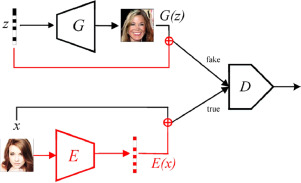当前位置:
X-MOL 学术
›
Pattern Recogn.
›
论文详情
Our official English website, www.x-mol.net, welcomes your feedback! (Note: you will need to create a separate account there.)
Training Bidirectional Generative Adversarial Networks with Hints
Pattern Recognition ( IF 8 ) Pub Date : 2020-07-01 , DOI: 10.1016/j.patcog.2020.107320 Uras Mutlu , Ethem Alpaydın
Pattern Recognition ( IF 8 ) Pub Date : 2020-07-01 , DOI: 10.1016/j.patcog.2020.107320 Uras Mutlu , Ethem Alpaydın

|
Abstract The generative adversarial network (GAN) is composed of a generator and a discriminator where the generator is trained to transform random latent vectors to valid samples from a distribution and the discriminator is trained to separate such “fake” examples from true examples of the distribution, which in turn forces the generator to generate better fakes. The bidirectional GAN (BiGAN) also has an encoder working in the inverse direction of the generator to produce the latent space vector for a given example. This added encoder allows defining auxiliary reconstruction losses as hints for a better generator. On five widely-used data sets, we showed that BiGANs trained with the Wasserstein loss and augmented with hints learn better generators in terms of image generation quality and diversity, as measured numerically by the 1-nearest neighbor test, Frechet inception distance, and reconstruction error, and qualitatively by visually analyzing the generated samples.
中文翻译:

使用提示训练双向生成对抗网络
摘要 生成对抗网络 (GAN) 由生成器和鉴别器组成,其中训练生成器将随机潜在向量转换为分布中的有效样本,并训练鉴别器将此类“假”示例与分布的真实示例分开。 ,这反过来又迫使生成器生成更好的假货。双向 GAN (BiGAN) 也有一个编码器,它在生成器的反方向上工作,以产生给定示例的潜在空间向量。这个添加的编码器允许将辅助重建损失定义为更好的生成器的提示。在五个广泛使用的数据集上,我们表明使用 Wasserstein 损失训练并增加提示的 BiGAN 可以在图像生成质量和多样性方面学习更好的生成器,
更新日期:2020-07-01
中文翻译:

使用提示训练双向生成对抗网络
摘要 生成对抗网络 (GAN) 由生成器和鉴别器组成,其中训练生成器将随机潜在向量转换为分布中的有效样本,并训练鉴别器将此类“假”示例与分布的真实示例分开。 ,这反过来又迫使生成器生成更好的假货。双向 GAN (BiGAN) 也有一个编码器,它在生成器的反方向上工作,以产生给定示例的潜在空间向量。这个添加的编码器允许将辅助重建损失定义为更好的生成器的提示。在五个广泛使用的数据集上,我们表明使用 Wasserstein 损失训练并增加提示的 BiGAN 可以在图像生成质量和多样性方面学习更好的生成器,



























 京公网安备 11010802027423号
京公网安备 11010802027423号